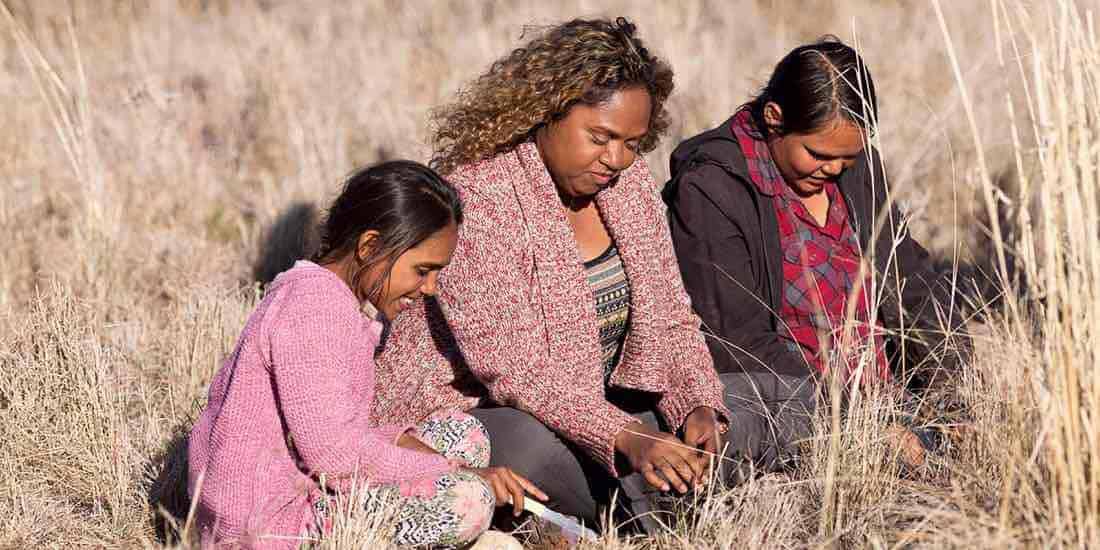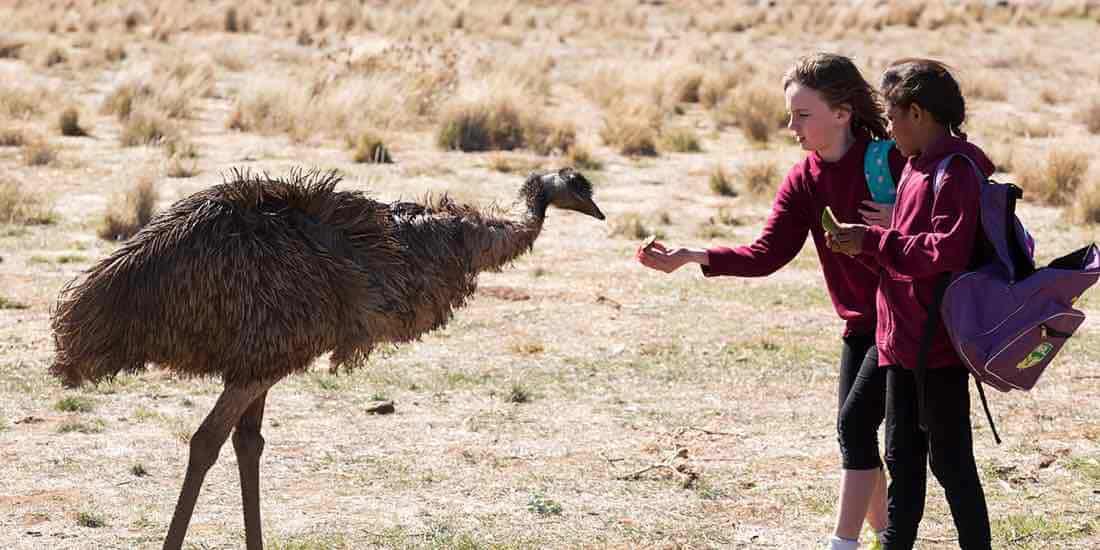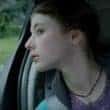Director Imogen Thomas discusses her feature, Emu Runner, which explores an Aboriginal girl’s (Rhae-Kye Waites) grief — and her community’s resilience — after her mother’s death.

The opening scene of Emu Runner, Imogen Thomas’s debut feature, immerses us in the arid grassland of Brewarrina, an indigenous community a day’s journey from Sydney, Australia. Gem (Rhae-Kye Waites), the film’s nine-year-old protagonist, looks upon her surroundings with a sense of wonder, but she also depends on her mother to help her decipher the natural world. When an emu appears in the distance, her mother explains, “That’s a dad with his young ones. It’s the dad who looks after them.” These observations prove portentous: after Gem’s mother passes away suddenly, her father becomes a single parent. The film chronicles the family’s resilience as a unit, despite a social worker’s muddled efforts to “help.”
Winningly, Emu Runner toes the line between childlike and childish — it never gives into the latter, but Thomas captures the not-uncomplicated joy of youth. After her mother’s passing, Gem pushes back against her father’s authority by skipping school and snatching produce from the neighbours’ yards to feed her new neighbour, a wild emu. Through this interspecies friendship, Gem stays connected to her mother, and, as director Imogen Thomas explained to me in our interview, she also learns to let go, to accept that the emu has a life cycle — a journey — of his own.
[click_to_tweet tweet=”‘Winningly, Emu Runner toes the line between childlike and childish — it never gives into the latter, but Thomas captures the not-uncomplicated joy of youth.'” quote=”‘Winningly, Emu Runner toes the line between childlike and childish — it never gives into the latter, but Thomas captures the not-uncomplicated joy of youth.'”]
Like the social worker in this film, Thomas is an outsider in Brewarrina, but she worked closely with Frayne Barker, the director of a local preschool, to make the film and to incorporate the guidance of indigenous leaders. The cast is mostly comprised of non-professional actors, many of whom were Rhae-Kye Waites’s relatives. Meanwhile, the film’s narrative also emphasizes the power of family and community; Gem is never without that love.
On the phone, Thomas and I spoke about filmmaking as a form of community engagement, the role of animals in the film, and her choice to tell a story about grief from a child’s perspective.
Seventh Row (7R): How did you decide to make this film?
Imogen Thomas (IT): I have had a very long relationship with Brewarrina, the community where I made the film. I went to Brewarrina in 2003 to work with a non-profit organization on an arts initiative. I engaged with women in the community, particularly indigenous women who were using a shelter called Ourgunya. I particularly engaged with Frayne Barker, who ran the indigenous preschool in the community.
After finishing a short film called Mixed Bag in 2008, we started to have bigger dreams. We wanted to explore the impact that loss has on the individual, family, and broader community — how grief ripples through the region because the families in Brewarrina are interconnected.
[click_to_tweet tweet=”‘We wanted to explore the impact that loss has on the individual, family, and broader community — how grief ripples through the region because the families in Brewarrina are interconnected.’ – Imogen Thomas” quote=”‘We wanted to explore the impact that loss has on the individual, family, and broader community — how grief ripples through the region because the families in Brewarrina are interconnected.’ – Imogen Thomas”]
This topic felt especially pressing because, at the beginning of last year, one of the elders in the community, Mary Waites, informed me that a community member who was associated with the film had passed away. I was quite sad about the news. Then she turned to me and said, “So when are we going to make this film? We really need this film. I think this film would be really important for healing, and we need a project.” I said, “You’re right. Let’s make this film.”
We didn’t have any money. I had a little bit of personal savings, and that was our launching pad. It was quite liberating. I said, “I’ll do my very best to see what resources I can pull together,” while Mary was on the ground in Brewarrina, expressing our intentions to make this film and build community engagement. As much as we wanted to produce a film, it was also about engaging in a process and building a platform that would bring the community together.
[click_to_tweet tweet=”‘As much as we wanted to produce a film, it was also about engaging in a process and building a platform that would bring the community together.’ – Imogen Thomas” quote=”‘As much as we wanted to produce a film, it was also about engaging in a process and building a platform that would bring the community together.’ – Imogen Thomas”]
7R: How did you involve the community in the filmmaking process?
IT: As filmmaker, I was an outsider — I do not live in the community, I’m not indigenous — so I needed to listen and to take guidance. At every juncture in the film’s production, I consulted with Frayne, who would guide and direct me. She would say, “We need to talk to my aunt and uncle who live two hours away in Lightning Ridge.” They would be able to impart cultural knowledge, which was be really important for this story. So many people stepped up and said, “Yeah, of course, you can borrow my trailer,” or “I can give you a certain number of hours of work,” or “Of course, you can use our house for the set.” The film willed its way into existence.
[click_to_tweet tweet=”‘As filmmaker, I was an outsider — I do not live in the community, I’m not indigenous — so I needed to listen and to take guidance.’ – Imogen Thomas” quote=”‘As filmmaker, I was an outsider — I do not live in the community, I’m not indigenous — so I needed to listen and to take guidance.’ – Imogen Thomas”]
The filmmaking process was equally or even more important than the end result. I had a documentary-style crew, and I worked with non-trained actors, so I had to be very nimble and agile. We wanted to have as little footprint in the actors’ lives as possible, so as not to impinge on their instincts. While Emu Runner is a fiction film, it is also the community’s story. The actors slip into the narrative with ease and grace because they understand [how it feels to have similar experiences.]
The Ngemba culture is very rich and thousands of years old. I feel a huge responsibility because the community members trust me to tell their story, with their help, using the skills I have. Also, Frayne was very adamant that this story didn’t stereotype her people. I could have turned the lens and focused on the broken parts of the community — but this is very much about trying to celebrate the beauty and the strong elements of the people, as well as the landscape.
[click_to_tweet tweet=”‘The Ngemba culture is very rich and thousands of years old. I feel a huge responsibility because the community members trust me to tell their story, with their help, using the skills I have.’ – Imogen Thomas” quote=”‘The Ngemba culture is very rich and thousands of years old. I feel a huge responsibility because the community members trust me to tell their story, with their help, using the skills I have.’ – Imogen Thomas”]
7R: Why did you choose to tell the story from a child’s perspective?
IT: I struggled with this question for a while. I jumped around perspectives, looking through the lens of one character, then another. Ultimately, I felt that the most gripping and poignant way to tell this story was through the child’s perspective, partly because children don’t have all the baggage of adults.
Also, I had the privilege of shadowing Frayne, who works with children and their families, as well as social services. She had to put out fires and support families so they could maintain their autonomy. Finally, I had no money, and I realized that I couldn’t make a film from my original 139-page script, which included a more detailed exploration of the adult characters. I had to pare it down to this little girl’s story because that’s what I had the resources to achieve.
[click_to_tweet tweet=”‘I felt that the most gripping and poignant way to tell this story was through the child’s perspective, partly because children don’t have all the baggage of adults.’ – Imogen Thomas” quote=”‘I felt that the most gripping and poignant way to tell this story was through the child’s perspective, partly because children don’t have all the baggage of adults.’ – Imogen Thomas”]
7R: The film turns on a reversal of traditional gender roles: after Gem’s mother’s death, her father becomes Gem and siblings’ primary caregiver. Why did it feel important to tell this story?
IT: The women are very strong in Brewarrina. It’s a matriarchal society, so women hold the families together, but we wanted to tell a story that portrayed men in very strong roles. We wanted to show a father stepping up and taking on that enormous role of trying to keep his family together during a devastating time. While he is struggling, he has to keep going to make ends meet. He is also under the scrutiny of his own culture, [just as social services begins to question] him and his capacity.
[click_to_tweet tweet=”‘ The women are very strong in Brewarrina. It’s a matriarchal society, so women hold the families together, but we wanted to tell a story that portrayed men in very strong roles.’ – Imogen Thomas” quote=”‘ The women are very strong in Brewarrina. It’s a matriarchal society, so women hold the families together, but we wanted to tell a story that portrayed men in very strong roles.’ – Imogen Thomas”]

7R: The film teems with animals of all kinds — from insects and kangaroos to reptiles and birds, including, of course, the emu. Why did you choose to foreground animals in the film?
IT: There is a long tradition of telling stories about children and their relationship with animals. Animals have a capacity to impart a deeper understanding of nature, which mends, rejuvenates, and gives us a sense of our place in the world. In this film, nature is a counterweight against the grief — [it takes Gem to a different place where she can find] some solace and healing. The Ngemba are very much in synergy with their country, and it’s something that I hold in incredible awe.
For Gem, the emu, in particular, is very special because it is her mother’s totem, so there is a real communion between her and the animal. She wants to hold onto something, but she also learns you can’t always hold on to nature. She has to let that animal go. It has to be wild — it has its own life cycle and journey. [What happens in Gem’s family also] parallels the emu’s life cycle. The father emu raises the chicks: he sits on the nest until the chicks hatch. He only gets water from the morning dew. It’s his role to take these little chicks to adulthood, so nature mimics the film’s narrative.
[click_to_tweet tweet=”‘For Gem, the emu, in particular, is very special because it is her mother’s totem, so there is a real communion between her and the animal. She wants to hold onto something, but she also learns you can’t always hold on to nature.’ – Imogen Thomas” quote=”‘For Gem, the emu, in particular, is very special because it is her mother’s totem, so there is a real communion between her and the animal. She wants to hold onto something, but she also learns you can’t always hold on to nature.’ – Imogen Thomas”]
7R: How did you shoot the scenes with the emu?
IT: The emu scenes were shot on a farm about four hours away from the film’s primary location. The challenge was to try to marry these two worlds so that viewers would believe everything was happening in the same space. We could only shoot facing west because there were massive mountains in the opposite direction, which do not match the landscape of Brewarrina.
On the farm, we had a lot of control while working with the animals, but we also had the liberty to do a bit of experimentation. Emus are not animals that can be trained, so you can’t always script these scenes. On my birthday, I wanted to see how emus would react to music. I bought a pile of CDs like Madonna and Vivaldi — different genres of music. We let Rhae-Kye play the music, and she and the emu had this sort of communion — they were both listening, and how they interacted in the space was enormously powerful. These moments sort of develop organically, and they’re quite magical.
[click_to_tweet tweet=”‘I bought a pile of CDs like Madonna and Vivaldi — different genres of music. We let Rhae-Kye play the music, and she and the emu had this sort of communion — they were both listening, and how they interacted was enormously powerful.’ – Imogen Thomas” quote=”‘I bought a pile of CDs like Madonna and Vivaldi — different genres of music. We let Rhae-Kye play the music, and she and the emu had this sort of communion — they were both listening, and how they interacted was enormously powerful.’ – Imogen Thomas”]
7R: How is the social worker’s character important to the film’s political message?
IT: Brewarrina is a very remote place geographically. It’s a community of just under 2000 people. A lot of people who arrive are transient [like the social worker in the film]. They come for very short periods of time to work in health and education. People come with the best of intentions, but there is not a lot of continuity. It’s quite difficult for this community. [Also, these people] come, like we all do, with their own experiences and frameworks, which sometimes get in the way of being able to be very helpful. Sometimes, we need to step back and realize maybe we need to do more listening rather than imposing what we think is best. Our sense of engagement needs to happen in our own neighborhood.
[click_to_tweet tweet=”‘Sometimes, we need to step back and realize maybe we need to do more listening rather than imposing what we think is best.’ – Imogen Thomas” quote=”‘Sometimes, we need to step back and realize maybe we need to do more listening rather than imposing what we think is best.’ – Imogen Thomas”]

7R: How did you cast Rhae-Kye Waites as Gem?
IT: I held informal, open auditions at the government school and the Catholic school in Brewarrina. I pared it down to a few children, and then I needed to find children whose families supported [their participation in the film.] You need a lot of support to be able to do this kind of work, [considering] the demands of shooting six days a week.
The legal obligations and conditions when you’re working with children are strict in Australia. I had to abide by those laws to protect Rhae-Kye and myself. Had she not had family, we would not have the film. Her grandmother plays her grandmother; her grandfather plays her uncle; her cousin plays her sister. So she was surrounded by her loved ones, and they helped her when she was really struggling.
[click_to_tweet tweet=”‘Had she not had family, we would not have the film. Her grandmother plays her grandmother; her grandfather plays her uncle; her cousin plays her sister. So she was surrounded by her loved ones.’ – Imogen Thomas” quote=”‘Had she not had family, we would not have the film. Her grandmother plays her grandmother; her grandfather plays her uncle; her cousin plays her sister. So she was surrounded by her loved ones.’ – Imogen Thomas”]
It’s a very personal film for Rhae-Kye. During the pickup shoot, we needed a shot of Rhae-Kye for the scene where her father is driving her home after the rescue. I told her, “You’ve done this big run, and you’re exhausted. You’re with family again, and you’re going home. I want you to fall asleep.” She turned to me and said, “Imogen, I can’t pretend to be asleep. I’m either awake or asleep. I’m not asleep. I’m awake.” But we did about three takes on a dirt road in the back of town, and with the vibrations of riding in the truck — and it had been a long, hot day — she just fell asleep. It was a strange irony.
At one point halfway through shooting the film, Rhae-Kye said, “I can’t do this film anymore. It’s too hard, Imogen, man.” She often called me “Imogen, man.” “Okay, well you need to go home,” I said. We were all feeling shattered. Rhae-Kye was taken home. But as I was coming out of the house with Mary Waites, Rhae-Kye’s grandmother, she spotted a flock of emus that had come up from the river. The emus hadn’t come into town for twenty years, which some people thought was due to the drought. Mary went back inside and called Rhae-Kye, who came out to look. As a proud Ngemba woman, Mary believed the emus were the ancestors calling Rhae-Kye back to go and do the film, but it had to be on her terms. We felt that these ancestors were there watching us.
[click_to_tweet tweet=”‘As a proud Ngemba woman, Mary believed the emus were the ancestors calling Rhae-Kye back to go and do the film, but it had to be on her terms.’ – Imogen Thomas” quote=”‘As a proud Ngemba woman, Mary believed the emus were the ancestors calling Rhae-Kye back to go and do the film, but it had to be on her terms.’ – Imogen Thomas”]
You may also like our other articles about the limits and politics of social services
Here at Seventh Row, several of our recent essays have explored the limits and politics of social services, including this meditation on the Debra Granik’s oeuvre and our review of Ken Loach’s I, Daniel Blake. As part of our TIFF coverage this year, we also interviewed Paddy Breathnach about the making of his film Rosie and its depiction of the blind spots and loopholes in Ireland’s social safety net. Finally, we recommend our interview with director Warwick Thornton about Sweet Country, one of Alex Heeney’s favourite films from last year’s TIFF, which tells a story about an Indigenous farmworker-turned-outlaw in northern Australia.

